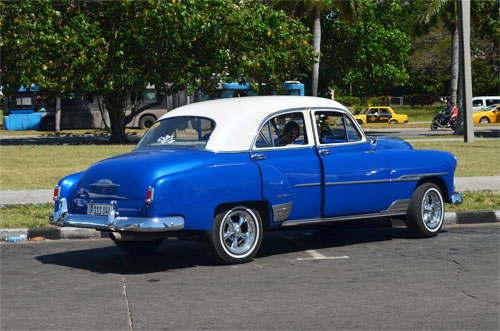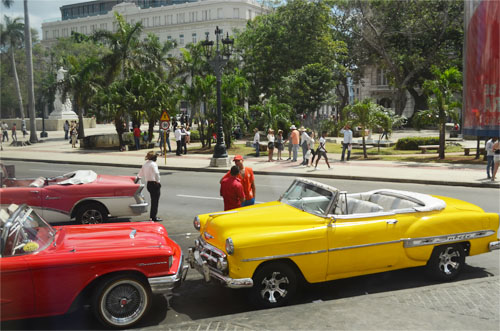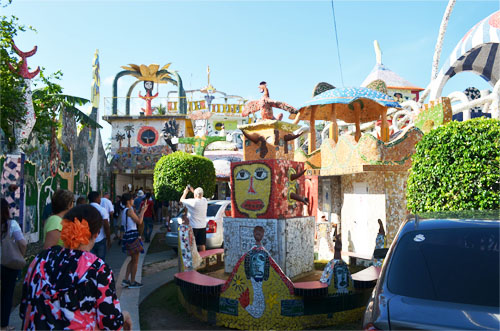As mentioned in our last blog post, my wife and I celebrated our 25th wedding anniversary in Cuba. Visiting Cuba is like stepping back in time — to the 1960’s. This post is to provide a little background information on Cuba (based on what we learned and by talking with Cubans). The Cuban people are friendly, warm, and welcoming to Americans.

A Bit of Cuban History
Up until 1492, Cuba had been inhabited for 10,000 years by an indigenous people, similar to our Native Americans. The Spanish (Christopher Columbus) began conquering the island in 1492 and eventually killed off the indigenous population with European disease. The Spanish ruled until 1898 when Cuban and American forces defeated the Spanish in the Spanish-American War and made Cuba a free land.
After the war, America occupied Cuba for a few years as it transitioned to a democratic nation with elected officials. Corruption was rampant and the American mob began running the island with the backing of President Batista during the 1950’s.
In 1953, Fidel Castro (a well-educated lawyer) with a group of other intellectuals wanted to overthrow Batista by storming the Moncada Barracks, you can still see the bullet holes in the front of the building. Fidel’s aim was to free the Cuban people from corruption, eliminate the mob, provide literacy training for all Cubans and to provide a better life for Cubans.

The coup attempt effort failed and the members of Fidel’s group were either killed or jailed. Fidel was sentenced to 15 years but was soon released by Batista as amnesty was given to many political prisoners. Fidel fled to Mexico and resurrected his attempt to overthrow the government. He succeeded in 1959 and Batista fled the country. Fidel ruled the country as a communist state until his death in 2016.
Why Were Americans Banned from Visiting?
America provided arms to Batista during the revolution and Fidel resented it. In 1961, the USA also tried to overthrow Fidel’s new government when the CIA invaded the country at the Bay of Pigs but the attempt was thwarted. Relations deteriorated as Cuba began imposing high import taxes on American goods. America responded by imposing a trade embargo, not allowing any American companies to do business with Cuba and preventing Americans from visiting.

The Soviet Union seized this opportunity by offering to support Cuba by replacing all American trade with Russian trade — Russia would purchase anything America was blocking with the trade embargo. As Russia and Cuba solidified a closer relationship, Cuba transitioned to a Communist state.
The Cuban Missile Crisis
In1962, relations deteriorated with Cuba and Russia when American spy satellites spotted Soviet nuclear missiles on the island of Cuba, pointed at the USA. This resulted in a dangerous confrontation between the USA and the Soviet Union, bringing the USA to DEFCON2 level — the closest we’ve ever been to a nuclear war. After tense negotiations, John F. Kennedy and Nikita Khrushchev quelled the crisis by Russia agreeing to remove the missiles if the USA agreed to remove nuclear missiles in Turkey and agree not to attack Cuba. If you want to learn more about this, check out this article.
The Cuban Revolution
After Cuba and the USA cut ties, Cuba began trading with Russia and transitioned to a Communist state. Cuba nationalized all American owned companies, which means the Cuban government took over the companies, the casinos that were previously run by the mob, and took possession of all of the mansions that lined the coast of Havana.

Castro gave these mansions to Cuban peasants with several families living in the same home — an incredible improvement in their lifestyle. They also turned many of them into government offices.

Castro also implemented a 1-year project (Cuban Literacy Campaign) to eradicate illiteracy in small towns all around Cuba where literacy was just 60%. The effort was implemented by deploying teenagers, young adults and teachers all around Cuba to teach illiterate Cubans to read and write Spanish. This campaign was very successful, resulting in 96% of Cubans becoming literate within a year. Many of the Literacy Campaign’s volunteers went on to pursue teaching careers, and the rate of teachers is now 11 times higher than it was before the revolution.
A Socialist Cuba
As Cuba converted to Communism, the government continued to trade heavily with the Soviet Union and many Cubans will tell you that life felt better than when under Batista’s regime. Although Cubans could not start their own businesses, they received food, free education and healthcare, cheap housing and employment from the government. Many of the peasants felt much better off but entrepreneurial Cubans felt trapped and many fled the country.
However, the government did not invest in Cuban infrastructure. We visited many parts of the town and you can see the impact of that with buildings beginning to crumble from neglect. Cuba is now starting to invest in renewing buildings but the problem is overwhelming.


This is not to say that Cuba does not have beautiful buildings, they really do. There are squares and really old buildings that are impressive, especially in Old Havana, where you see cobblestone streets and Spanish-inspired buildings.



As you take tours, they take you to the new Havana and they are very proud of this area. However, to Americans, it feels like a place stuck in time. The buildings are reminiscent of 1960, with an architecture similar to what you would have seen in 1960’s Miami.



And of course, you see all of the wonderful 1950 American cars. You will see some newer Russian and Cuban cars but about 70% of their cars are pristine 1950’s American cars. It is like being stuck in time — in a wonderful way.






Normalizing Relations with the United States
After Fidel Castro’s death, the USA and Cuba began normalizing relations. This now allows us to travel to Cuba as long as we do in as an Educational Exchange tour. I actually prefer this because you get to learn a lot about Cuba.
It’s not fully normalized yet. For example, if you bring American currency, they charge you a 10% tax just for converting the money. If you are planning to go to Cuba, purchase Euro or Canadian dollars from your local bank and convert those when you get to Cuba so that you don’t incur the 10% penalty.
With the collapse of the Soviet Union in 1990, Cuba was left without a major trading partner and it really affected them economically. The average wage for a Cuban working for the government is just $25 per month but most get their basic needs met from the government with free education, healthcare, low-cost housing, and food.
Cubans are also resourceful. Many Cubans have relatives living in other countries that send money. Tour guides also take tips so they can earn hundreds of dollars per day — much more than the normal Cuban government wage. We found Cuba to be extremely safe, you can walk around at night with no worries. The people are incredibly friendly and appreciate the warming of relations with America. Although they have endured hardship from their government, they are a proud people who love their country.
Now is a great time to visit Cuba because it still feels like a land stuck in time. Eventually, as normalization matures, Cuba will become more wealthy and this nostalgic feeling will subside.
Things to See
When visiting Havana, you will obviously want to visit Old and New Havana. But here are a few things you will surely want see that’s a little off the beaten path.
Fusterlandia
Fusterlandia is a town on the outskirts of Havana that was renovated with ceramic tiles by a local artisan, fashioned after the works of Gaudi. When we visited Spain, we saw similar architecture by Gaudi in Park Guell.



Floridita
Ernest Hemingway lived in Cuba for over 10 years and wrote For Whom the Bell Tolls there. One of his favorite hangouts was the Floridita, the birthplace of the daiquiri. Enjoy latin music and sip on the best daiquiri you will ever drink.

Old American Car Tour
For just $40 an hour, get a personalized tour of Havana in an old American car. Our driver took us to find Cuban cigars, to a nature preserve and a ride along the ocean.



Conclusion
I hope you enjoyed this post on our trip to Cuba, you can see last month’s post about Cuba here.
If you are not subscribed to our blog and would like to subscribe so that new posts come directly to your email, scroll up to the right top section of this page and type in your email address.
I’ll leave you with a final picture of the view we had as we entered the bay into Havana as we viewed the iconic Morro Castle.




